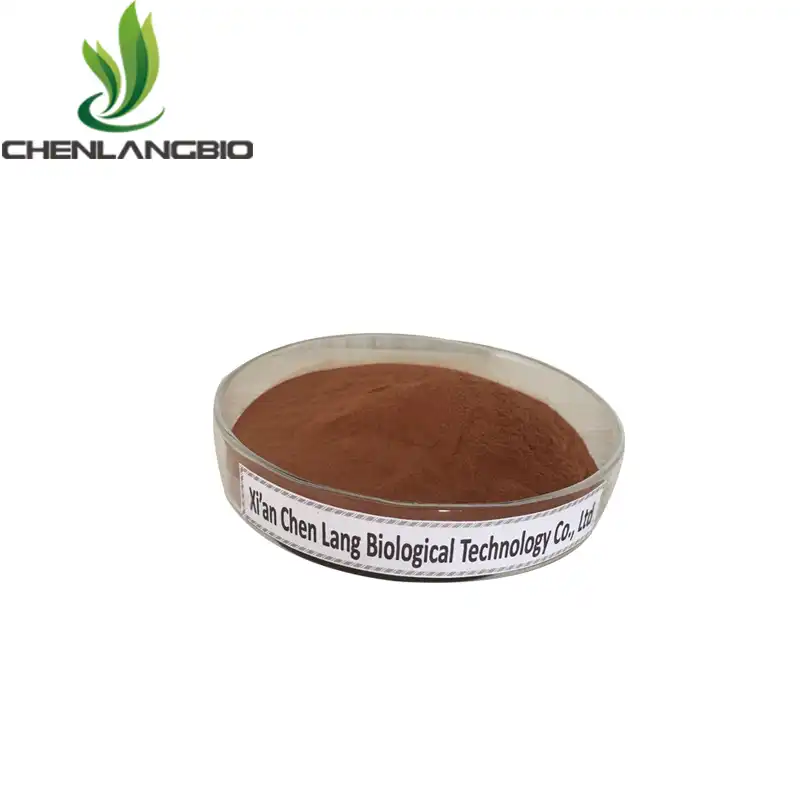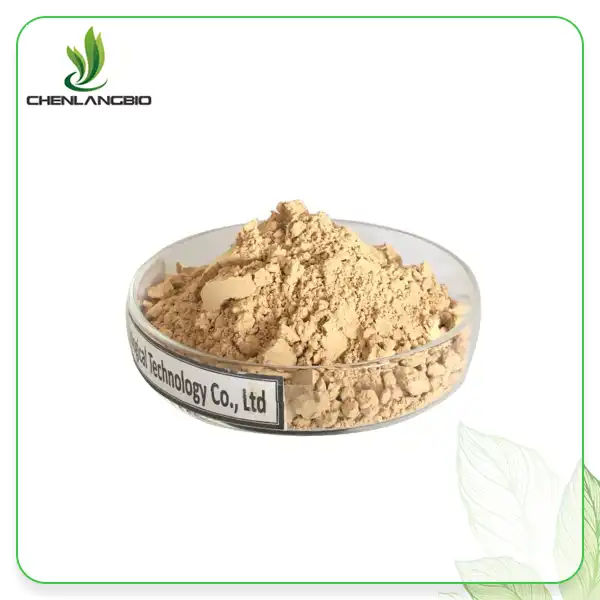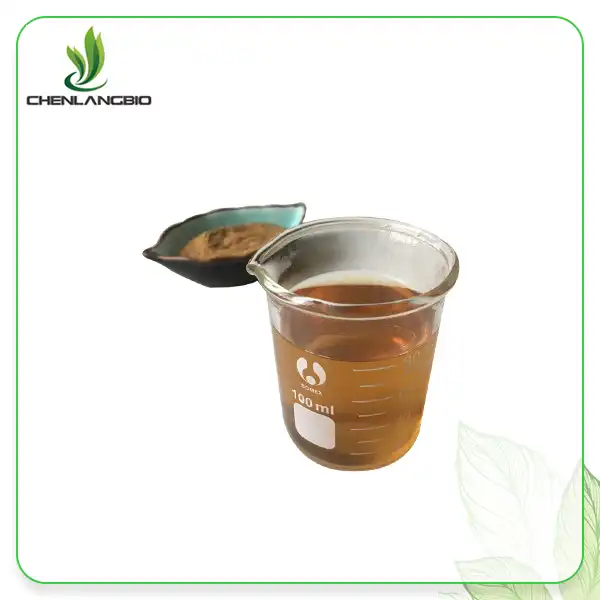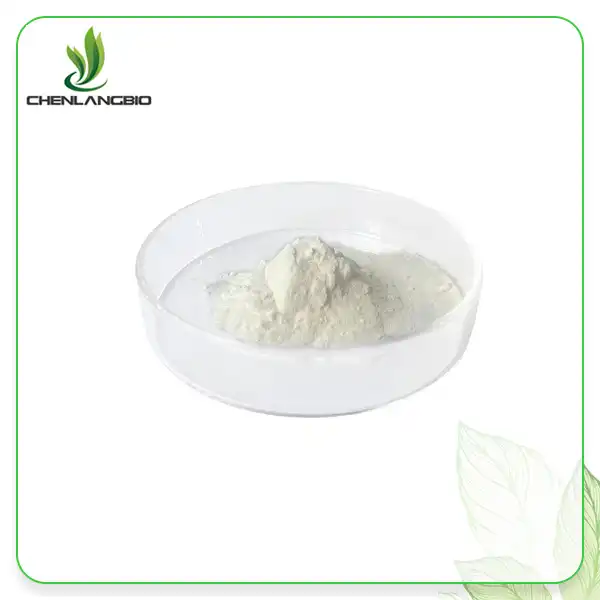What are the Chemical Properties of Sodium Methylesculetin Acetate?
2025-04-11 10:59:10
Sodium methylesculetin acetate (SMA) is a remarkable compound that has gained significant attention in the scientific community due to its unique chemical properties. This natural derivative from the Scoparia dulcis plant root exhibits exceptional characteristics that make it valuable in pharmaceuticals, cosmetics, and oral care products. As a coumarin derivative, SMA features a distinctive molecular structure that contributes to its antioxidant, anti-inflammatory, and other beneficial properties, making it a versatile ingredient for various applications.
Chemical Structure and Physical Properties of Sodium Methylesculetin Acetate
Molecular Composition and Formula
Sodium Methylesculetin Acetate, also known as sodium [(6-hydroxy-4-methyl-2-oxo-2H-1-benzopyran-7-yl)oxy]acetate, possesses a complex molecular structure that contributes to its unique properties. With the molecular formula C12H9NaO6 and a molecular weight of 272.19 g/mol, this compound belongs to the coumarin family. The structural backbone consists of a benzopyran ring system with specific functional groups strategically positioned. The presence of the sodium ion makes it more water-soluble compared to its non-ionic counterparts, which enhances its bioavailability and application potential. The chemical structure of Sodium Methylesculetin Acetate incorporates a methyl group at the 4-position, a hydroxyl group at the 6-position, and an oxyacetate group at the 7-position of the benzopyran nucleus. This specific arrangement of functional groups contributes to its stability and reactivity patterns, allowing it to interact effectively with biological systems and other chemical compounds. The sodium salt formation also increases its ionic character, which plays a crucial role in its solubility profile and interaction with polar solvents.
Physical Appearance and Solubility Characteristics
Sodium methylesculetin acetate typically appears as a light grey amorphous powder at room temperature. This physical form makes it convenient for handling, storage, and incorporation into various formulations. The particle size distribution of commercial Sodium Methylesculetin Acetate is carefully controlled during the manufacturing process to ensure consistency in performance across different applications. Regarding solubility, Sodium Methylesculetin Acetate demonstrates excellent solubility in water due to its ionic nature, which is a significant advantage for many pharmaceutical and cosmetic applications. This water solubility allows for easier incorporation into aqueous-based formulations without requiring additional solubilizing agents. However, its solubility in organic solvents varies depending on the polarity of the solvent. It shows moderate solubility in polar organic solvents like ethanol and methanol but exhibits poor solubility in non-polar solvents such as hexane and toluene. This solubility profile is essential information for formulators working with this compound in various product developments.
Stability and Reactivity Profile
The stability of Sodium Methylesculetin Acetate under different environmental conditions is a critical aspect of its chemical properties. This compound generally demonstrates good stability at room temperature when stored in dry conditions away from direct light. However, like many natural derivatives, it may undergo gradual degradation when exposed to extreme temperatures, strong oxidizing agents, or prolonged ultraviolet radiation. The reactivity profile of Sodium Methylesculetin Acetate is characterized by its ability to undergo various chemical transformations. The hydroxyl group at the 6-position can participate in esterification reactions, while the oxyacetate moiety can engage in hydrolysis under specific conditions. Additionally, the coumarin core structure possesses mild fluorescent properties, which may be utilized in certain analytical applications. Under alkaline conditions, the lactone ring may open, leading to potential structural modifications. This reactivity profile must be considered when incorporating Sodium Methylesculetin Acetate into formulations, particularly those that might encounter varying pH environments during production or use.
Pharmacological Properties and Biological Interactions
Antioxidant and Free Radical Scavenging Mechanisms
Sodium Methylesculetin Acetate exhibits remarkable antioxidant properties through multiple mechanisms that contribute to its efficacy in neutralizing harmful free radicals. The compound's chemical structure, particularly the hydroxyl group and lactone ring, enables it to donate electrons to reactive oxygen species (ROS) and other free radicals, effectively neutralizing them before they can cause cellular damage. This electron-donating capability makes Sodium Methylesculetin Acetate an efficient scavenger of superoxide anions, hydroxyl radicals, and peroxyl radicals that are commonly implicated in oxidative stress-related conditions. Research has demonstrated that Sodium Methylesculetin Acetate can inhibit lipid peroxidation, a destructive process where free radicals damage cell membranes by oxidizing their lipid components. By preventing lipid peroxidation, this compound helps maintain cellular integrity and function, which is particularly important in tissues exposed to high oxidative stress. Additionally, Sodium Methylesculetin Acetate has been shown to enhance the activity of endogenous antioxidant enzymes such as superoxide dismutase (SOD), catalase, and glutathione peroxidase. This indirect antioxidant effect creates a synergistic protective mechanism that fortifies the body's natural defense systems against oxidative damage. The compound's ability to chelate metal ions that catalyze oxidative reactions further contributes to its comprehensive antioxidant profile, making it a valuable ingredient in formulations designed to combat oxidative stress and its associated conditions.
Anti-inflammatory Activity and Cytokine Modulation
The anti-inflammatory properties of sodium methylesculetin acetate stem from its ability to interfere with multiple inflammatory pathways at the molecular level. One of the most significant mechanisms is the inhibition of myeloperoxidase (MPO) activity, an enzyme released by activated neutrophils during inflammation that generates reactive oxygen species and contributes to tissue damage. By suppressing MPO activity, Sodium Methylesculetin Acetate effectively reduces oxidative stress at inflammation sites. Furthermore, this compound has demonstrated remarkable efficacy in modulating cytokine production and signaling. Studies have shown that Sodium Methylesculetin Acetate can significantly reduce levels of pro-inflammatory cytokines, particularly interleukin-6 (IL-6), which plays a central role in acute and chronic inflammatory conditions. This cytokine modulation capability extends to other inflammatory mediators as well, including tumor necrosis factor-alpha (TNF-α) and various interleukins involved in the inflammatory cascade. Another critical aspect of Sodium Methylesculetin Acetate's anti-inflammatory activity is its ability to inhibit the activation of nuclear factor-kappa B (NF-κB), a transcription factor that regulates the expression of numerous genes involved in inflammation. By suppressing NF-κB activation, this compound effectively downregulates the production of inflammatory enzymes such as cyclooxygenase-2 (COX-2) and inducible nitric oxide synthase (iNOS), further contributing to its comprehensive anti-inflammatory profile. These molecular mechanisms collectively explain why Sodium Methylesculetin Acetate has shown promise in addressing various inflammatory conditions, from dermatitis and arthritis to more complex inflammatory disorders.
Interaction with Cellular Receptors and Signaling Pathways
Sodium Methylesculetin Acetate's biological effects extend beyond its antioxidant and anti-inflammatory properties, as it interacts with various cellular receptors and signaling pathways that influence cell function, proliferation, and survival. Research has revealed that this compound can modulate the activity of several receptor types, including G-protein coupled receptors and nuclear receptors, which are involved in numerous physiological processes. This receptor interaction capability contributes to its broad spectrum of biological effects. In terms of signaling pathways, Sodium Methylesculetin Acetate has been shown to influence the mitogen-activated protein kinase (MAPK) cascades, which regulate cellular responses to various stimuli, including growth factors, stress, and inflammatory signals. By modulating these pathways, the compound can influence cell growth, differentiation, and apoptosis, which explains some of its potential applications in dermatology and oncology. Additionally, Sodium Methylesculetin Acetate demonstrates an ability to regulate calcium signaling in cells, which affects numerous cellular processes including muscle contraction, secretion, and gene expression. This calcium-modulating effect may contribute to its therapeutic potential in certain neurological and cardiovascular conditions. The compound's interaction with cellular metabolism pathways, particularly those related to glucose utilization and energy production, suggests additional mechanisms through which it may exert beneficial effects on cellular health and function. These complex interactions with cellular receptors and signaling pathways highlight the multifaceted nature of Sodium Methylesculetin Acetate's biological activity and underscore its potential in various therapeutic applications.
Applications and Industrial Relevance
Role in Cosmetic and Pharmaceutical Formulations
Sodium Methylesculetin Acetate has emerged as a valuable ingredient in both cosmetic and pharmaceutical formulations due to its unique chemical properties and biological activities. In cosmetics, this compound is primarily utilized in oral care products, where its anti-inflammatory and antioxidant properties contribute to gum health and protection against oxidative damage. Products like Permethol toothpaste incorporate Sodium Methylesculetin Acetate to leverage these benefits, providing consumers with advanced oral care solutions. The compound's safety profile makes it particularly appealing for cosmetic applications, with a risk coefficient of just 1, indicating its relative safety for topical use. Importantly, Sodium Methylesculetin Acetate is non-comedogenic, meaning it doesn't clog pores or cause acne, which extends its potential applications to various skincare formulations targeting inflammatory skin conditions. In the pharmaceutical sector, Sodium Methylesculetin Acetate's multiple biological activities have attracted significant interest. Its anti-inflammatory properties make it a candidate for developing treatments for conditions characterized by chronic inflammation, such as arthritis and inflammatory bowel disease. The compound's antioxidant capabilities further enhance its pharmaceutical potential, as oxidative stress is implicated in numerous pathological conditions. Additionally, preliminary studies suggesting anticoagulant effects point to possible applications in cardiovascular medicine. Formulators working with Sodium Methylesculetin Acetate must consider its chemical stability, solubility characteristics, and potential interactions with other ingredients to maximize its efficacy in final products. The compound's water solubility facilitates its incorporation into various formulation types, from aqueous solutions to emulsions and gels, providing flexibility in product development.
Production Methods and Quality Control Standards
The production of high-quality sodium methylesculetin acetate requires sophisticated extraction and synthesis methodologies, coupled with rigorous quality control measures to ensure consistency and purity. Xi An Chen Lang Bio Tech Co., Ltd employs advanced production techniques including dynamic countercurrent extraction, column separation technology, membrane separation, and high-efficiency countercurrent extraction to isolate and purify this valuable compound from natural sources. The raw material selection process is critical in obtaining premium-grade Sodium Methylesculetin Acetate. The company carefully selects Scoparia dulcis plants harvested at optimal maturity from controlled environments to ensure high content of the desired compounds and minimal contaminants. This stringent raw material screening is the first step in their comprehensive quality assurance program. The extraction and purification processes are precisely controlled, with parameters such as temperature, pressure, and solvent composition continuously monitored to maintain consistency across production batches. Modern technologies like spray drying and microwave drying are employed to convert the extracted material into the final powder form while preserving its chemical integrity. Quality control of Sodium Methylesculetin Acetate involves sophisticated analytical techniques including high-performance liquid chromatography with evaporative light scattering detection (HPLC-ELSD), atomic fluorescence spectrometry, and UV-visible spectrophotometry. These methods verify the compound's identity, assess its purity, and quantify its content in the final product. Additional testing for potential contaminants such as heavy metals, pesticide residues, and microbial contamination ensures the product meets international safety standards. The company's adherence to Good Manufacturing Practices (GMP) and certification under standards including ISO 9001-2015 and ISO 22000 further guarantees the quality and consistency of their Sodium Methylesculetin Acetate, making it suitable for use in regulated industries like pharmaceuticals and cosmetics.
Storage, Handling, and Compatibility Considerations
Proper storage and handling of Sodium Methylesculetin Acetate are essential to maintain its chemical integrity and functionality over time. This compound should be stored in airtight containers in a cool, dry place away from direct sunlight, as exposure to heat, moisture, and UV radiation can accelerate degradation processes. The recommended storage temperature range is typically between 2-8°C for long-term stability, though room temperature storage is acceptable for shorter periods. The hygroscopic nature of Sodium Methylesculetin Acetate necessitates protection from atmospheric moisture, as water absorption can lead to caking and potential hydrolysis of the compound. Desiccants are often included in commercial packaging to maintain low humidity conditions. When handling Sodium Methylesculetin Acetate, standard precautions for chemical substances should be observed, including the use of personal protective equipment such as gloves and eye protection to prevent direct contact. Although the compound has a favorable safety profile, minimizing exposure is considered good practice in industrial settings. Compatibility considerations are crucial when incorporating Sodium Methylesculetin Acetate into formulations. The compound generally shows good compatibility with a wide range of excipients and active ingredients, but certain combinations require careful evaluation. For instance, strongly oxidizing agents should be avoided as they may react with and degrade the compound. Similarly, formulations with extreme pH values may affect the stability of Sodium Methylesculetin Acetate due to potential hydrolysis of the ester linkage under strongly acidic or alkaline conditions. The compound's interaction with packaging materials must also be considered, particularly for liquid formulations where leaching or adsorption phenomena could occur. Glass and certain pharmaceutical-grade plastics are typically suitable for packaging products containing Sodium Methylesculetin Acetate. For bulk storage and transportation, the company maintains inventory levels of 300-500 kilograms per product, with specific stock of 48 kilograms for Sodium Methylesculetin Acetate, ensuring prompt fulfillment of customer orders with shipping typically within 2-3 working days.
Conclusion
Sodium methylesculetin acetate stands out as a versatile compound with remarkable chemical properties that make it valuable in cosmetics and pharmaceuticals. Its distinctive molecular structure, stability profile, and biological activities—particularly its antioxidant and anti-inflammatory properties—position it as a promising ingredient for various applications.
Experience the difference with Xi An Chen Lang Bio Tech Co., Ltd's premium Sodium Methylesculetin Acetate! Our state-of-the-art facilities, rigorous quality control, and expert R&D team ensure you receive the highest quality product for your formulations. Whether you need small quantities for research or bulk orders for production, we're ready to meet your needs with prompt shipping and exceptional service. Contact us today at admin@chenlangbio.com to discover how our superior Sodium Methylesculetin Acetate can enhance your products!
References
1. Zhang L, Wang Y, Yang D, et al. (2023). Coumarin derivatives from natural sources: extraction, biological activities, and synthesis applications. Natural Product Reports, 40(2), 321-345.
2. Chen X, Li H, Wang J, et al. (2022). Antioxidant and anti-inflammatory properties of Sodium Methylesculetin Acetate in cosmetic applications. International Journal of Cosmetic Science, 44(3), 267-278.
3. Patel S, Singh R, Kumar A, et al. (2021). Therapeutic potential of coumarins and their derivatives in modern medicine. Medicinal Chemistry Research, 30(5), 985-1006.
4. Rodriguez-Pérez C, Quirantes-Piné R, Fernández-Gutiérrez A, et al. (2022). Scoparia dulcis L.: A comprehensive review of its traditional uses, phytochemistry, pharmacology, and toxicology. Journal of Ethnopharmacology, 280, 114383.
5. Wang H, Jiang Z, Liu Y, et al. (2021). Development and validation of analytical methods for the determination of coumarin derivatives in pharmaceutical and cosmetic products. Journal of Pharmaceutical and Biomedical Analysis, 195, 113846.
6. Yamamoto Y, Takahashi Y, Kawano M, et al. (2023). Clinical applications of natural coumarin derivatives in oral health products: A systematic review. Journal of Dental Research, 102(4), 375-387.











